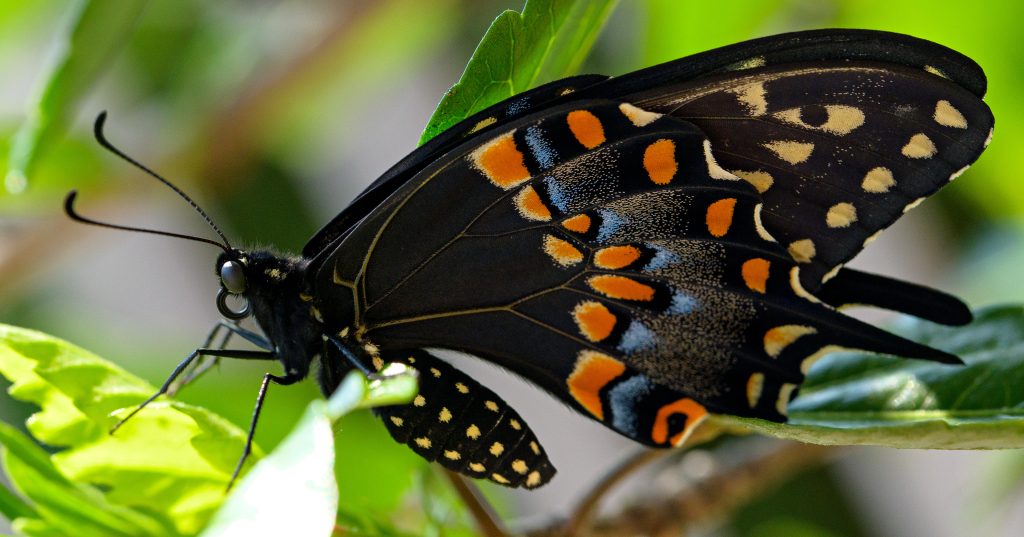If you live in Southern Canada, Eastern or Southern US, or Mexico, you may be in a place where Black Swallowtail (also called Eastern Black Swallowtail) butterflies live. These beautiful large butterflies are one of over 500 species of swallowtails, and one of the more common ones to be seen in urban areas of their habitat.
Swallowtail butterflies in general are large with bold colours, and most have the characteristic ‘tail’ that looks so similar to the tail of a Swallow (bird). Although their populations aren’t in danger at the moment, watching them grow from tiny egg to butterfly is a magical experience that I believe helps us to connect with nature. If you’re interested in learning how to care for these beautiful creatures, keep scrolling.
1. Find the eggs
- They will look like tiny, perfectly round (except for a SLIGHT flat edge where they attach to the plant), creamy white-to-yellow balls about 1mm diametre. Black Swallowtails lay their eggs on plants related to carrots:
- carrot greens
- dill
- fennel
- rue
- golden alexander
- Queen Anne’s lace
- celery
- (and in some areas – citrus trees!)
2. Bring the eggs inside
- Although many eggs will hatch in the wild, the little round eggs are a perfect ‘protein pop’ for many snacking predators, so you will increase their chances of survival by sheltering them indoors.
- Many of the plants that eggs are found on do NOT like to be removed from the garden, and will quickly wilt. One thing that you can do to help is to plant a pot of the caterpillar’s food, then lay found leaves with eggs on top of the healthy potted leaves. When the egg hatches, it can quickly crawl away from the wilted leaf and start eating the fresh, healthy leaf. Another thing that you can do is to replenish picked leaves often, and try to sustain them for longer by placing the stems in a vase with water.
3. Store the eggs and caterpillars
- I usually keep these caterpillars in open-topped jars and on greens rising our of vases. Unlike milkweed leaves for Monarchs, which don’t wilt that quickly in an enclosed environment, the food of the Black Swallowtail will dry out and rot easily. As long as I keep the caterpillars well fed, they stay with their jar or vase. If you really don’t want them to escape, consider placing a cover (like an upside down tote container) over your set-up.
4. Feed the caterpillars
- In general, the caterpillars want to eat the same food for all of their lives. If you find an egg that was laid on fennel and starts to eat fennel leaves, it won’t be very happy if suddenly you try to feed it carrot greens. They also eat A LOT. Check that they have enough to eat at least twice a day.
5. Let the caterpillars hang from something sturdy
- A stick works well! Thin enough that the caterpillar can reach around it to attach it’s silks, but sturdy enough that it won’t collapse. The caterpillars are great at attaching themselves to many places, though. If they get loose in your home, they may attach themselves under chairs or tables or even along power cords! Placing a lid loosely on a jar containing the caterpillar and some food can prevent them from ‘going rogue’.
6. Release the butterflies
- Almost as soon as they hatch, the butterflies are ready to go outside – but they may hang out nearby for a long time if conditions are damp. Take advantage of their hesitation to take lots of pictures!

Throughout our summers here in Southern Ontario, Black Swallowtails will go through 2-3 generations, and the last pupae set will overwinter until Spring. You can start finding eggs as early as a few weeks after the last frost, and keep finding them until just a few weeks before the first. Keep those food sources growing in your garden, and the butterflies will keep coming back for more – hopefully helping to pollinate your other plants at the same time!
